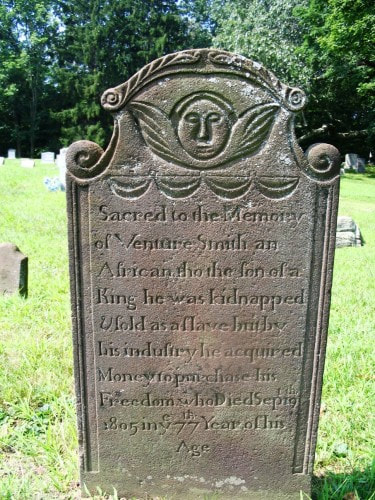Venture Smith, 18th Century Black Entrepreneur (1729 - 1805)
1729
Venture Smith's grave is one of the original sites on the Connecticut Freedom Trail. "In recognizing the importance to Connecticut of numerous sites in the state that are associated with the heritage and movement towards freedom of its African American citizens, the Connecticut General Assembly in 1995 authorized that these locations be developed into a Freedom Trail. Included on the Trail are buildings used on the Underground Railroad, sites associated with the Amistad case of 1839-1842, and gravesites, monuments, homes and other structures that represent the concept of freedom so cherished in the American mind".
Timeline compiled in July 2005 and last revised in 2015 by Karl P. Stofko, Municipal Historian.
1729
- Born Broteer Furro, the eldest son of King Saungm Furro of the tribe of Dukandarra in Guinea.
- Captured about 1737 in his 7th year and sold for "4 gallons of rum and some calico" at Anomabo on Africa's Gold Coast to Robinson Mumford, the steward of a Rhode Island slave ship.
- He was renamed Venture, having been purchased by Mumford's own private venture.
- He grew up as a slave on Fishers Island, New York, which was being leased by the Mumford family at that time.
- Married about 1750 to Meg (Marget), another Mumford slave, with whom he had 4 children.
- After a failed escape attempt, Venture was sold to Thomas Stanton 2nd of Pawcatuck in Stonington, CT.
- Sold to Hempstead Miner of New London and subsequently loaned to Daniel Edwards Esq. of Hartford.
- Purchased for the last time by Oliver Smith of Stonington. Mr. Smith allowed Venture to purchase his freedom about 1765, and in return Venture took the name Smith as his surname.
- Lived and worked on Long Island to raise the necessary money to purchase the freedom of his wife and children. During these years he labored at cutting wood, farming, fishing, and spent 7 months on a whaling voyage.
- Sold all his land on Lona Island and Stonington and moved his family to East Haddam. where he worked for Timothy Chapman and Abel Bingham for 2- 3 months. He began purchasing land at Haddam Neck along the Salmon River Cover from Bingham and others. By his industry his farm grew to 134 acres with 3 houses, 20 boats, canoes and sailing vessels, 2 fishing businesses, and a commercial orchard. His entrepreneurial ventures included river trafficking, lumberjacking, carpentry and farming. All of this was accomplished without the ability to either read or write. His two sons Cuff and Solomon left descendants, many of whom still live in Connecticut.
- Dictated his autobiography, published in pamphlet form by Charles Holt, editor of the New London "Bee". It has been reprinted many times since. It is one of just 11 slave narratives of the 18th century, and the only one that recounts life in Africa. His life story has been an inspiration for many people over the years.
- Died on September 19, 1805, a highly respected man by all in the Haddams. He was survived by his wife, 2 sons, and 7 grandchildren. He is buried in First Church Cemetery in East Haddam with his wife Marget (1730-1809), son Solomon (1774-1843), and grandchildren Eliza Ann Smith Roy (1826-1902), Rena Smith (1794-1808), and Jack Smith (1801-1840), Venture's gravestone was carved by John Isham Jr. of East Haddam while Silas Brainerd, also of East Haddam, carved Marget's gravestone. The graves of Rena and Jack, children of Cuff, are marked with plain field stones. Solomon was a veteran of the War of 1812 and Cuff, a veteran of the Revolutionary War.
Venture Smith's grave is one of the original sites on the Connecticut Freedom Trail. "In recognizing the importance to Connecticut of numerous sites in the state that are associated with the heritage and movement towards freedom of its African American citizens, the Connecticut General Assembly in 1995 authorized that these locations be developed into a Freedom Trail. Included on the Trail are buildings used on the Underground Railroad, sites associated with the Amistad case of 1839-1842, and gravesites, monuments, homes and other structures that represent the concept of freedom so cherished in the American mind".
Timeline compiled in July 2005 and last revised in 2015 by Karl P. Stofko, Municipal Historian.

